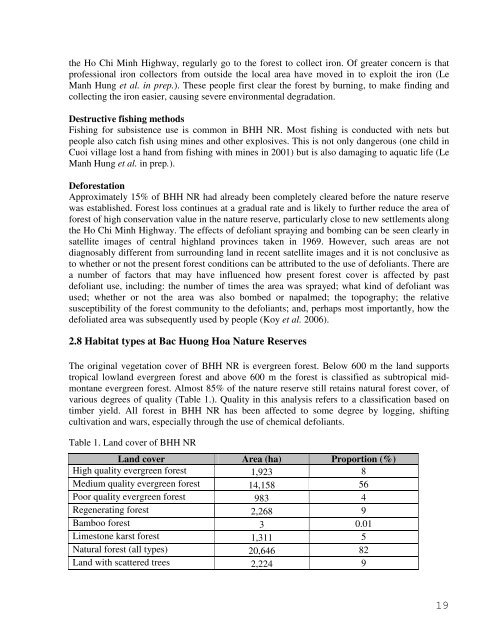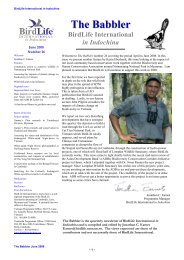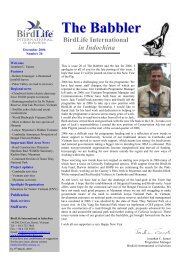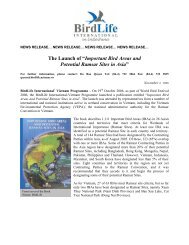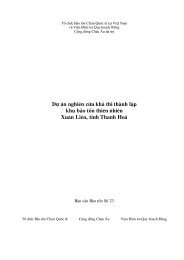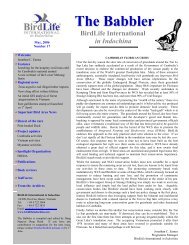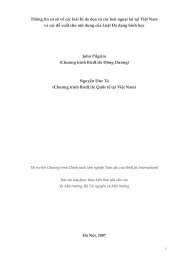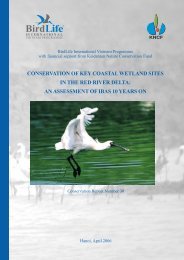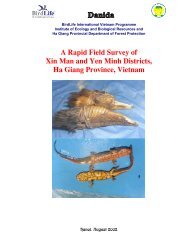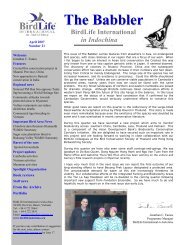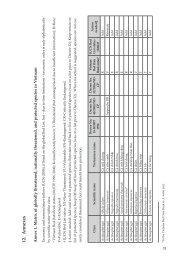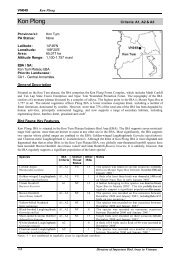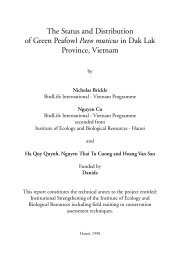The Biodiversity of Bac Huong Hoa Nature Reserve - Birdlife ...
The Biodiversity of Bac Huong Hoa Nature Reserve - Birdlife ...
The Biodiversity of Bac Huong Hoa Nature Reserve - Birdlife ...
You also want an ePaper? Increase the reach of your titles
YUMPU automatically turns print PDFs into web optimized ePapers that Google loves.
the Ho Chi Minh Highway, regularly go to the forest to collect iron. Of greater concern is that<br />
pr<strong>of</strong>essional iron collectors from outside the local area have moved in to exploit the iron (Le<br />
Manh Hung et al. in prep.). <strong>The</strong>se people first clear the forest by burning, to make finding and<br />
collecting the iron easier, causing severe environmental degradation.<br />
Destructive fishing methods<br />
Fishing for subsistence use is common in BHH NR. Most fishing is conducted with nets but<br />
people also catch fish using mines and other explosives. This is not only dangerous (one child in<br />
Cuoi village lost a hand from fishing with mines in 2001) but is also damaging to aquatic life (Le<br />
Manh Hung et al. in prep.).<br />
Deforestation<br />
Approximately 15% <strong>of</strong> BHH NR had already been completely cleared before the nature reserve<br />
was established. Forest loss continues at a gradual rate and is likely to further reduce the area <strong>of</strong><br />
forest <strong>of</strong> high conservation value in the nature reserve, particularly close to new settlements along<br />
the Ho Chi Minh Highway. <strong>The</strong> effects <strong>of</strong> defoliant spraying and bombing can be seen clearly in<br />
satellite images <strong>of</strong> central highland provinces taken in 1969. However, such areas are not<br />
diagnosably different from surrounding land in recent satellite images and it is not conclusive as<br />
to whether or not the present forest conditions can be attributed to the use <strong>of</strong> defoliants. <strong>The</strong>re are<br />
a number <strong>of</strong> factors that may have influenced how present forest cover is affected by past<br />
defoliant use, including: the number <strong>of</strong> times the area was sprayed; what kind <strong>of</strong> defoliant was<br />
used; whether or not the area was also bombed or napalmed; the topography; the relative<br />
susceptibility <strong>of</strong> the forest community to the defoliants; and, perhaps most importantly, how the<br />
defoliated area was subsequently used by people (Koy et al. 2006).<br />
2.8 Habitat types at <strong>Bac</strong> <strong>Huong</strong> <strong>Hoa</strong> <strong>Nature</strong> <strong>Reserve</strong>s<br />
<strong>The</strong> original vegetation cover <strong>of</strong> BHH NR is evergreen forest. Below 600 m the land supports<br />
tropical lowland evergreen forest and above 600 m the forest is classified as subtropical midmontane<br />
evergreen forest. Almost 85% <strong>of</strong> the nature reserve still retains natural forest cover, <strong>of</strong><br />
various degrees <strong>of</strong> quality (Table 1.). Quality in this analysis refers to a classification based on<br />
timber yield. All forest in BHH NR has been affected to some degree by logging, shifting<br />
cultivation and wars, especially through the use <strong>of</strong> chemical defoliants.<br />
Table 1. Land cover <strong>of</strong> BHH NR<br />
Land cover Area (ha) Proportion (%)<br />
High quality evergreen forest 1,923 8<br />
Medium quality evergreen forest 14,158 56<br />
Poor quality evergreen forest 983 4<br />
Regenerating forest 2,268 9<br />
Bamboo forest 3 0.01<br />
Limestone karst forest 1,311 5<br />
Natural forest (all types) 20,646 82<br />
Land with scattered trees 2,224 9<br />
19


